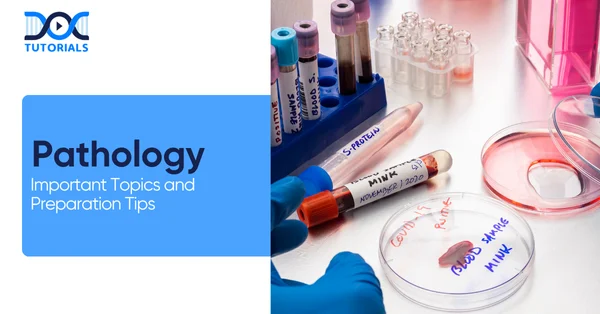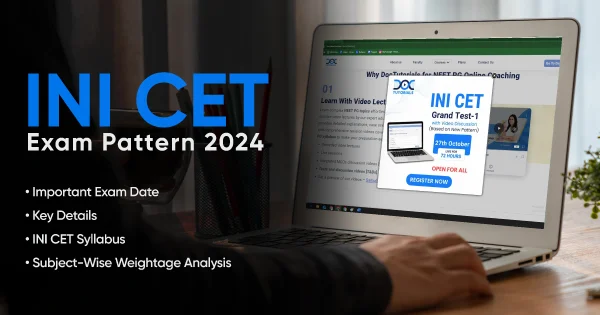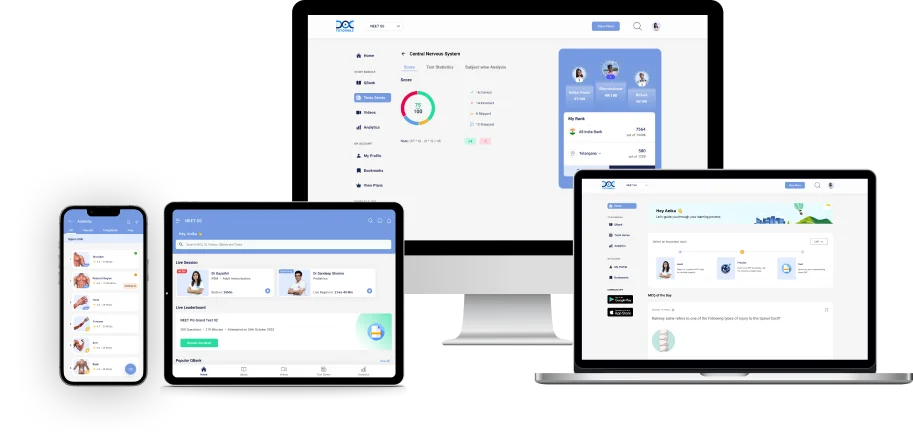Pathology: Important Topics and Preparation Tips

Pathology is a key milestone in your MBBS journey, where the science of disease truly comes alive. The second-year students are no longer focused on anatomy and physiology but are learning why diseases occur, their effects on tissues, and the body changes they cause.
The subject of pathology is of high weightage to NEET PG aspirants and contributes significantly to exam performance. This guide will discuss the top pathology topics to study in MBBS and NEET PG and smart study tips that will enable you to learn concepts, do well in practicals and score higher.
Whether you’re in your second year or starting NEET PG prep, this guide will help you study smart and build a strong foundation in pathology. Keep reading!
How to Study MBBS Pathology Effectively?
Pathology is a comprehensive second-year MBBS course, which deals with disease processes, their causes and the alterations they cause to the organs and tissues. It forms the connection between the basic sciences (anatomy, physiology, biochemistry) and clinical medicine. Here is a detailed overview:
- To learn pathology is to know why diseases occur – why inflammation produces pus, why a blockage of an artery produces tissue infarction.
- It can also entail the skills in the laboratory, such as the interpretation of blood tests or the biopsy slides, which doctors use on a daily basis.
- Pathology in MBBS comprises important field topics like cellular pathology, histology, haematology and systemic pathology.
- There are also a high number of exams with a practical spotter component (recognising slides, specimen images, and lab values).
- Frequently checking the slide pictures, blood smears, and test charts will ensure that you pass in both the theory and practical sections.
- Pathology has a high yield in competitive exams such as NEET-PG: an average of 12 questions (out of 200) are generally of pathology.
- A high mark in pathology will therefore have a great impact on your overall performance.
When studying pathology, it is better to study high-yield topics that are more likely to be discussed in exams. Focusing on these areas will help you to cover the material that is most likely to be tested.
The main areas are enumerated below:
- General Pathology (Cell Injury & Inflammation)
- Understand the causes and forms of cell injury (ischaemia, toxins, free radicals) and consequences (reversible vs. irreversible injury).
- Know the types of necrosis (coagulative, liquefactive, and caseous) and examples.
- Study acute inflammation (leukocyte margination, diapedesis, chemotaxis, etc.) and chronic inflammation (granuloma formation).
- Learn essential mediators (histamine, cytokines, prostaglandins).
- Discuss special conditions, such as amyloidosis (deposition of proteins in tissue) and various forms of shock.
- Neoplasia (Tumour Pathology)
- Study how cells become neoplastic and the features of tumours.
- Understand oncogenes vs. tumour suppressor genes and the hallmarks of malignancy.
- Study the distinction between benign and malignant (e.g., metastasis, anaplasia).
- Be familiar with tumour markers (AFP, CEA, PS, etc.) and paraneoplastic syndromes.
- Learn the examples of carcinogens (smoking-lung cancer, HPV-cervical cancer) and tumour nomenclature, e.g., adenoma vs. carcinoma.
- Focus on basic tumour staging concepts.
- Haematology
- Cover normal and abnormal blood.
- Know erythropoiesis and normal blood counts.
- Classify anaemia by cell size and cause: iron-deficiency vs. megaloblastic vs. haemolytic, and their lab findings (e.g. iron studies, MCV).
- Know about leukaemia and lymphoma (ALL, AML, CML, CLL, Hodgkin’s) as well as major markers (e.g. BCR-ABL in CML) and pathology (e.g., Auer rod in AML).
- Knowledge of coagulation disorders such as Haemophilia, von Willebrand disease and DIC.
- Train in CBC and image of blood smear interpretation (e.g., as in DIC, disc target cells in thalassaemia).
- Immunopathology & Genetics
- Pay attention to the malfunctions of the immune system.
- Learn hypersensitivity types I-IV (examples: allergy/anaphylaxis, SLE immune complexes, contact dermatitis, and tuberculosis skin test).
- Learn about types of autoimmune diseases (SLE, rheumatoid arthritis, and so on) and immunodeficiency syndromes (HIV/AIDS, SCID).
- Include transfusion medicine: ABO and Rh blood typing and haemolytic disease of the newborn. Review basic complement pathways and types of graft rejection.
- In genetics, memorise important chromosomal diseases (Down syndrome, Waardenburg syndrome, and Turner syndrome) and patterns of inheritance.
- Systemic Pathology
With reference to each organ system, focus on common diseases and pathology:
- Cardiovascular: The development of atherosclerosis, histopathology of myocardial infarction, rheumatic heart disease (Aschoff bodies), infective endocarditis and the sequelae of hypertension.
- Respiratory: Types of pneumonia (lobar and bronchopneumonia), tuberculosis (caseating granulomas), lesions of COPD (chronic bronchitis and emphysema), asthma lesions, and primary tumours of the lung (squamous cell vs. adenocarcinoma).
- Gastrointestinal: Peptic ulcer disease, inflammatory bowel disease (ulcerative colitis vs. Crohn), viral hepatitis (B vs. C histology), cirrhosis patterns and GI cancers (colon carcinoma staging).
- Renal: Glomerulonephritides (e.g., post-streptococcal GN vs. minimal change disease), diabetic glomerulopathy (Kimmelstiel-Wilson nodules), acute tubular necrosis, and kidney stones.
- Endocrine: Diabetes mellitus (autoinflammatory insulitis in Type I; islet amyloid in Type II), thyroid (Hashimoto lymphocytic thyroiditis, Graves disease), adrenal (pheochromocytoma) and pituitary adenoma.
- CNS: Meningitis (bacterial vs. viral inflammation), stroke (infarct timeline changes), neurodegeneration (Alzheimer’s, plaques, Parkinson’s, Lewy bodies, etc.), and brain tumour (glioblastoma, meningioma).
- Others: Examine breast lesions (fibroadenoma vs. carcinoma) and simple skin pathology (malignant melanoma vs. benign nevi). Paediatric tumours of the blood, such as retinoblastoma (RB gene), can be tested as well.
Discuss all these topics, examining both mechanisms and defining features. Always associate lesions with clinical scenarios (e.g., site-specific lesions with portal hypertension presentation). Use case examples and pathology images as you study – this helps you to consolidate what you are studying.
Effective Note-Taking and Active Learning for MBBS Pathology
The best way to master pathology is by developing good note-taking habits and working strategies. These few tips will assist you in studying smarter, improving retention and performing better.
- Take Clear and Well-Structured Notes
Brief and systematic notes are very crucial in pathology. Write straightforwardly during lectures and draw flowcharts (e.g., steps of inflammation) and comparison tables (e.g., nephrotic vs. nephritic syndromes) to simplify difficult material. It is easy to revise the structured notes that one keeps concerning all topics.
- Use Visual Tools and Mind Maps
Turn written information into diagrams, charts, and mind maps to get a faster comprehension of disease mechanisms. As an example, the Cell Injury map can be transformed into reasons, transformations, and illustrations. Visual representations improve understanding, and the last-minute review becomes effective.
- Practice Active Recall and Self-Testing
Quiz yourself to increase retention. Use flashcards with hot spots such as “What stain detects amyloid?” or “List signs of acute inflammation.” Write each topic as a one-page high-yield sheet and read it repeatedly to enhance memory.
- Review and Revise Daily
Take 10 -15 minutes every day and look at your flashcards and notes. Short, consistent revisions keep concepts fresh, prevent forgetting, and build long-term connections between related topics.
- Write by Hand and Use the Cornell Method
Handwriting stimulates thinking and paraphrasing, and makes you understand better. To remain both organised and focused on study time, attempt the Cornell approach, where you can write notes on one side of the paper, and keywords in the margin, with the bottom of the page occupied by a summary.
- Rephrase, Explain, and Teach Concepts
Close your book and speak about the topics after studying, either to yourself or your friend. Teaching entrenches knowledge, reveals the weak points, and builds confidence in discussing viva and exams.
- Highlight Key Points and Use Mnemonics
Make notes of varying categories selected by colour-codes (e.g., blue stains, green hormones). Learn long lists of things, such as necrosis types or tumour markers, by adding mnemonics or acronyms. Colour and visual cues assist in eliciting recall during exams.
- Stay Positive and Combine Smart Techniques
Pathology may be heavy-handed, and better engagement can be achieved through a combination of different teaching methods, such as diagrams, flashcards, discussions with colleagues, and analogies. As an example, consider the various types of necrosis. Remain inspired by measuring your progress and having your NEET PG target in view so that you always remember what you are doing.
Study Strategy and Syllabus Planning for MBBS Pathology
Pathology demands clever strategising and consistent practice – a clear study plan makes you stay on track and allows you to explore large topics effectively. Here’s what you need to do:
- Adopt a Systematic, Disciplined Approach
The first step is to plan the whole syllabus and have milestones. As an example, set aside 2-3 weeks to be spent on general pathology/haematology and 1-2 weeks each on each of the major systems (leaving the last month to review and take the final test).
- Use a Checklist or Calendar to Keep Track of Yourself
The most useful tip would be to master one subject before progressing to the next. Finish an entire chapter and answer all its practice questions before going on. This guarantees depth and memory.
- In Every Block, Focus on Meaning and Not Memorising
Read a textbook or view a lecture, write down notes and then have practice questions on the same topic. Provided that some of the subjects (such as immunology) are difficult, you should spend more time studying early, so that you can go over them later. Make a list of high-yield sub-topics (e.g. know the five classic causes of acute inflammation).
- Regular Self-testing is Key
Once you have learnt a topic, do as many MCQs as you can. Simulate a test using a NEET-PG question bank and quizzes under timed conditions. Break down all the errors: rethink ideas until they become familiar. This research-test-review cycle solidifies your education. Aim to complete approximately 2000-3000 MCQs in pathology from various sources.
- Theory is Enhanced Through Practice
Visit all pathology laboratories: examine tissues under the microscope and document them according to your notes. As an example, after studying the theory of malaria, examine a blood smear of Plasmodium through the microscope.
When your tests feature slide spotters, get ready by having a set of familiar pictures (e.g., Reed-Sternberg cells, malarial rings) that you will be expected to identify using only a glance at the picture. Develop a personal image bank of high-yield slides as much as possible.
- Re-read Every Subject After 1 Day, 1 Week, and a Month
Add a combination of old and new in every study session (e.g., use flashcards on other chapters first). During the (usually 2-4) weeks closest to the exam, transition to rapid-fire review: take complete mock examinations every day and scan through charts and one-liners of great importance (e.g., coagulation cascade, checkpoints of cell cycle).
- Have Goals Every Day and Take Breaks
Divide subjects into digestible segments (e.g., a section at a time) and intermix with other subjects to eliminate burnout. To be motivated, reward yourself when you achieve something (a break, snack, etc.).
You should add buffer days to your schedule in case of a delay, unexpected or external review. Maintain a healthy habit: exercise, nutritionally correct food, and sleep are essential – a fresh mind learns a lot more easily.
- Being Consistent is Crucial
Sometimes it is more effective to study a bit day by day than to study at the very end. With this schedule and practice of questions, you will go through the syllabus more efficiently and feel no panic.
Recommended Study Resources for MBBS Pathology
The correct material can help in making the process of preparation more efficient:
- Standard Textbooks & Review Books
Core books build your foundation. Textbook of Pathology by Harsh Mohan is highly recommended, as is Pathologic Basis of Disease, written by Robbins. For concise review, use focused texts: Essentials of Haematology & Clinical Pathology (Nayak & Rai) for blood topics and Review of Pathology & Genetics (Gupta & Garg) for high-yield points.
The Comprehensive Image-Based Review of Pathology by Soni is provided with charts and images to support the concepts. Pathology (MCQ book), Robbins Review of Pathology is also a helpful source. Look into long textbooks selectively (e.g., Robbins) where you are in need of clarification on a hard subject.
- Atlases & Slide Resources
Pathology is pictorial; therefore, research pictures. Review slides and specimens using histology, gross atlases (Robbins Atlas, Zubler), and online image banks (WebPath, PathologyOutlines). Practise identifying features in images: for instance, recognise Reed-Sternberg cells or fungal hyphae.
It is important to remember that a substantial number of NEET-PG questions contain images, and so one should feel comfortable looking at pictures on a slide. There are mobile applications that provide digital images in slides that one can swipe through using their mobile phone.
- Video Lectures
Videos are beneficial to visual learners. Useful sources are videos by Dr Sattar (Pathoma) (to get a conceptual understanding of the general pathology and oncology) and YouTube channels of experienced instructors (the tutorials of Armando Hasudungan, say, for one example).
Watch videos actively: not passively listening, but play the role of taking notes or stopping and reciting what you have learnt.
- Question Banks & Practice Tests
Revising questions is crucial. Students need to sharpen their ideas by revisiting the explanation (particularly as to the wrong answers). Go through previous NEET-PG-revision papers: many sites offer a subject-based NEET-PG pathology recall question set, comprising question responses, and an insight which delivers the most frequently posed subjects.
Complete full-length mock exams on time to become quick and to develop confidence during real-time exam scenarios.
- Flashcards & Mnemonics
Flashcards and mnemonics are useful for quick revision. Top scorers use flashcard apps (Anki, Quizlet) that have pre-made flashcards on pathology facts. It is also possible to develop your flashcards containing lists of tumour markers, stain colours, and other related information. Dr Devesh Mishra’s concise NEET pathology notes (bullet points) are famous as a last-minute review.
During the last days, work with the following brief resources: one-page charts and mnemonics that help you balance what you need to remember during an exam.
- Apps & Online Tools
Use smartphone applications and websites as additional practice. Some apps provide you with pathology questions of the day or offer flashcards. Resources may also be in the form of online pathology forums or study groups: explaining to others and observing the questions of other peers may address gaps in knowledge.
Lastly, it is all about quality, not quantity. It is preferable to read a small number of good books and be thorough with question banks rather than just read a large number of books. Rely on your college lecture note-taking and practicals – lecturers usually provide hints about the crucial topics.
Once you have a clear idea of a topic, you should have questions and review sheets to help grasp the concept. Putting these assets together with disciplined studying will ensure that your pathology preparation is rock solid.
Exam and Test-Taking Strategies for MBBS Pathology
Here are a few strategies that will help you apply your pathology knowledge effectively during the exam:
- Read Questions Carefully: Pay attention to wording. Phrases like “all of the following except” or absolute terms (always, never) can change the meaning. Underline or note these qualifiers before answering.
- Time Management: In NEET-PG, you get roughly 1.8 minutes per question. Keep track of time and avoid getting stuck on a single question. If unsure, mark it for review and move on; return later if time permits.
- Eliminate Options: First, rule out clearly incorrect choices. Often, two options can be dismissed right away. This improves your chances if you need to guess.
- Approach Image Questions: Examine any slide or image before looking at answers. Note the stain colour, cell arrangement, or other features, and recall similar photos from your studies.
- Answer First: When possible, try to answer from memory before glancing at the options. This prevents being misled by tricky distractors.
- Practice Under Exam Conditions: Regularly take full-length timed tests. This builds stamina and helps you become comfortable with the exam format.
- Night Before & Exam Day: In the final hours, focus on light revision of high-yield charts and get a good night’s sleep. On exam day, eat a healthy meal and remain calm. Read each question thoroughly and trust your preparation.
These strategies will help you apply your pathology knowledge effectively during the exam.
FAQs about Pathology: Important Topics and Preparation Tips
- How can I revise pathology effectively for NEET PG?
In order to revise effectively, utilise a combination of active recall, spaced repetition and MCQ practice. Begin by revising high-yield topics and making brief notes/flashcards. Test your knowledge using MCQs, review books, and online mediums. Video lectures may be used to solidify complicated ideas as well. Regular revision rather than cramming and solving old NEET PG papers to see the pattern and questions is recommended.
- How important is histopathology in medical exams?
Histopathology is a vital component of both MBBS practicals and NEET PG. You should be able to recognise key microscopic features of common diseases such as tuberculosis, cirrhosis, glomerulonephritis, and various cancers. Practise with histology slides in your college lab and use atlases or digital slide libraries to reinforce your learning. Being familiar with histological patterns not only helps in exams but also builds a strong foundation for clinical diagnosis.
- How can I integrate pathology with clinical subjects?
Integrating pathology with clinical subjects enhances understanding and retention. Try to connect pathological findings with clinical symptoms and diagnostic tests. For example, link nephrotic syndrome to glomerular changes observed under the microscope, or myocardial infarction to coagulative necrosis and ECG changes. This integrated approach not only helps in exams but also prepares you for clinical rotations and case discussions.
- What are the common mistakes students make while studying Pathology?
One common mistake is trying to memorise everything without understanding the underlying concepts. Pathology is best learnt through logic and correlation. Another mistake is neglecting histology and practicals, which are crucial for exams. Students also tend to skip MCQ practice until the last minute, which affects performance in NEET PG. Avoid cramming and instead focus on consistent, concept-based study with regular revision.
- How can I use diagrams effectively in pathology?
Diagrams are powerful tools for visualising processes like inflammation, cell injury, and tumour progression. Use labelled illustrations to understand and recall pathways. Practise drawing diagrams during revision to reinforce memory. In exams, neat and well-labelled diagrams can earn extra marks. You can also use digital tools like Notability or OneNote to create and organise diagrams for quick access.
Conclusion
The right strategy can help you make pathology one of your best MBBS subjects. Concentrate on learning, practise periodically, and apply active learning methods such as diagrams, flashcards, and self-examination. The connection between lab experiences and theory helps to memorise concepts.
DocTutorials offers MBBS pathology programmes with expert video lectures, curated questions, and high-yield practice modules to support your preparation. Combining these resources with disciplined self-study builds confidence and a strong foundation.
Simplify MBBS Pathology with DocTutorials!
Latest Blogs
-

INI CET Exam Pattern 2025: A Complete Guide with Subject-Wise Weightage
The Institute of National Importance Combined Entrance Test (INI CET) is your key to entering some of the most prestigious…
-

NEET PG Registration 2025: An Essential Guide For Exam Prep
The NEET PG registration, which is conducted online, is a crucial step in the exam process. Filling out the NEET…
-

NEET PG Syllabus 2026: A Must-Have Complete Guide for Exam Success
The NEET PG Syllabus acts as one of the foundation stones for aspiring postgraduate medical students like you who are…




